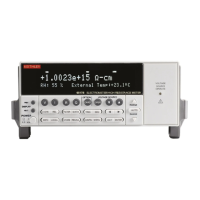Section 4: Basic measurements Model 6517B Electrometer Reference Manual
4-14 6517B-901-01 Rev. C / August 2015
Voltage burden
The input resistance of the ammeter causes a small voltage drop across the input terminals. This
voltage is known as the voltage burden. If the voltage burden is large in relation to the voltage of the
measured circuit, then significant measurement errors occur.
Refer to the figure below to see how voltage burden affects current measurements. Assume VS is 5
mV and RS is 5 k to configure a 1 µA current source (5 mV/5 k = 1 µA). An ideal ammeter with
zero voltage burden would measure the current source as follows:
In practice however, every ammeter has a voltage burden. If the voltage burden (VB) is 1 mV, the
current is measured as follows:
The 1 mV voltage burden caused a 20 % measurement error. Percent error in a measured reading
(IM) due to voltage burden can be calculated as follows:
The voltage burden of the Model 6517B depends on the selected range (see Accuracy Calculations
(on page A-1)). Voltage burden may be reduced by performing the offset adjustment procedure.
Figure 37: Voltage burden
Noise
Noise can seriously affect sensitive current measurements. The following paragraphs discuss how
source resistance and input capacitance affect noise performance.
Source resistance
The source resistance of the DUT affects the noise performance of current measurements. As the
source resistance is reduced, the noise gain of the ammeter increases.
The following figure shows a simplified model of the feedback ammeter. R
S
and C
S
represent the
source resistance and source capacitance, V
S
is the source voltage, and V
NOISE
is the noise voltage.
Finally, R
F
and C
F
are the feedback resistance and capacitance respectively.
The source noise gain of the circuit can be given by the following equation:

